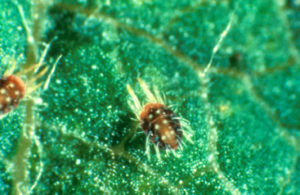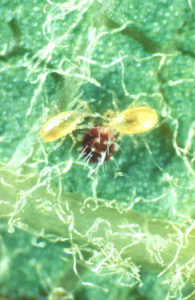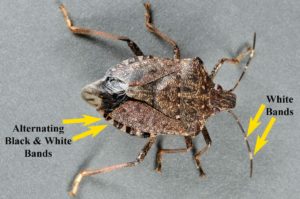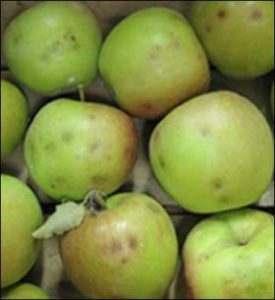Managing Mites in a BMSB World
For several decades, apple growers in Indiana and elsewhere in the Midwest have used a highly effective system to manage European red mites that is based on conservation of the predatory mite, Amblyseius fallacis, along with timely applications of either preventive or rescue miticides. The rationale behind this approach was that the predatory mites would provide the majority of the control of ERM, with miticides used as supplemental controls as needed. One of the primary tenets of the system was that growers should refrain, if possible, from using insecticides that were highly toxic to the predators. One group of insecticides that exhibited this high level of toxicity to predatory mites were the pyrethroids. Therefore, growers were frequently reminded to avoid using those products for fear of initiating a mite outbreak.
Table 1 shows the toxicity of many of our insecticides to predatory mites.
| Not Toxic | Slightly Toxic | Moderately Toxic | Highly Toxic |
| Bt | Diazinon | Lorsban | Asana |
| Cyd-X | Imidan | Supracide | Baythroid |
| Virosoft | Assail | Actara | Danitol |
| Centaur | Admire Pro | Permethrin | |
| Confirm | Belay | Proaxis | |
| Esteem | Avaunt | Warrior | |
| Intrepid | Delegate | Carzol | |
| Neem | Surround | Lannate | |
| Rimon | Sevin | ||
| Altacor | Vydate | ||
| Exirel | |||
| Entrust |
Table 1. Toxicity of insecticides to predatory mites.
One of the reasons this system was effective was that all of our pest insects could be controlled well with products that were not highly toxic to predatory mites. However, we now have to deal with an invasive pest, the brown marmorated stink bug (BMSB), that is very difficult to control. Products such as the pyrethroid insecticides are likely to be needed to manage this pest. BMSB can be severe, as evidenced by the tremendous losses experienced by fruit and vegetable growers on the eastern seaboard over the past 5-10 years.
BMSB was first detected in Indiana in Elkhart County in November 2010. Since that time, it has spread to all corners of Indiana. When invading a new region, BMSB typically will first become a household pest since it likes to overwinter inside homes to avoid our cold winters. Later, it will become a pest of fruits, vegetables, ornamental plants, corn and soybeans. Over the past several years, we have had sporadic reports of damage to various crops such as soybeans, sweet corn, and tomatoes, although in most cases, the damage was not severe. Now, for the first time, we have significant losses in a fruit crop, in this case apple. One Indiana grower reported losses up to 30% in some blocks of late maturing apples in 2016.
BMSB is capable of causing such significant losses that growers will need to do whatever is necessary to protect their crops, even if it means using products that will kill predator mites and potentially flare ERM populations. So, how does this change in pesticide use affect our European red mite management program? Here are my suggestions.
- Monitor your crops for BMSB. Don’t spray for them unless you have some evidence that they are there. You can use various types of traps or direct observations to determine their presence. Protect your crop from BMSB and deal with the consequences (ERM) later.
| Insecticide | Rate/A | PHI | Limitations |
| Lannate SP | 0.5 – 1 lb. | 14 | 5 lbs. 7 days between applications |
| Lannate LV | 1.5 – 3 pt. | 14 | 15 pts. 7 days between applications |
| Danitol 2.4EC | 16 – 21.33 fl. oz. | 14 | 42.67 fl. oz. |
| Mustang Maxx 0.8 EC | 1.28 – 4 fl. oz. | 14 | 24 fl. oz. 7 days between applications |
| Proaxis 0.5EC | 2.56 – 5.12 fl. oz. | 21 | 25.6 fl. oz. 20.48 fl. oz. after bloom |
| Warrior 1CS | 2.56 – 5.12 fl. oz. | 21 | 25.6 fl. oz. 20.48 fl. oz. after bloom |
| Endigo ZC | 5 – 6 fl. oz. | 35 | 28 fl. oz. 10 days between applications |
| Leverage 360 | 2.4 – 2.8 fl. oz. | 7 | 28 fl. oz. |
Table 2. Insecticide options for products on apples with stink bugs on the label.
| Insecticide | Rate/A | PHI | Limitations |
| Actara | 2 – 5.5 oz. | 14 – 35 | 16.5 oz. 10 days between applications |
| Assail 30 SG | 6 – 8 oz. | 7 | 4 applications; 12 days between applications |
| Admire Pro | 1.4 – 7 fl. oz. | 7 | 14 fl. oz. 10 days between applications |
Table 3. Insecticide options for products on apples without stink bugs on the label.
- If last year’s experience is indicative of what we can expect in the future, the need to control BMSB may be after we have stopped worrying about ERM for that season, so there may be no effect on ERM for that year.
- If possible, apply a Superior oil spray during the season after spraying for BMSB. If you are using captan prior to bloom, you will not want to apply oil.
- If you have sprayed for BMSB the previous year, you should seriously consider the use of one of the preventive miticides, Apollo, Savey, Agri-Mek, or Zeal, on the blocks you sprayed for BMSB.
| Good | Excellent |
| Agri-Mek | Apollo |
| Savey | |
| Zeal |
Table 4. Effectiveness of preventive miticides against European red mites.
- Beginning shortly after petal fall, begin scouting for ERM in the blocks that you sprayed for BMSB last year or where you would normally expect to see them first. Follow the spray threshold guidelines and treat with a rescue miticide if you exceed the threshold.
| Fair | Good | Excellent |
| Acramite | Agri-Mek | Envidor |
| M-Pede | Nexter | Kanemite |
| Summer Oils | Nealta | Portal |
| Vendex | Onager | Zeal |
| Dicofol |
Table 5. Effectiveness of rescue miticides against European red mites.
- Given the loss of predatory mites, you may need to apply more than one rescue miticide. If more than one application is necessary, choose a miticide with a different mode of action to avoid the development of resistance.
For more complete information about mite management, see https://extension.entm.purdue.edu/publications/E-258/E-258.pdf.



